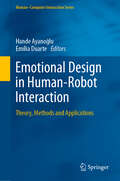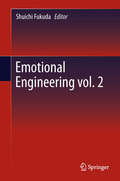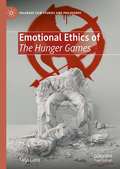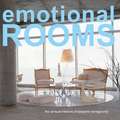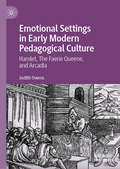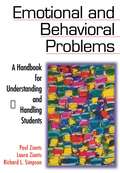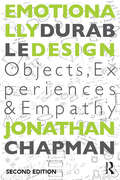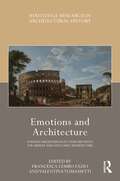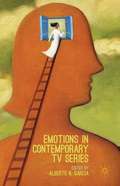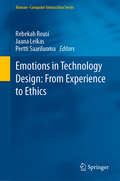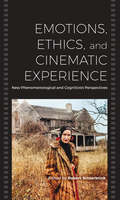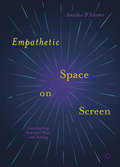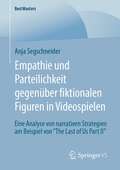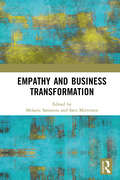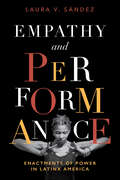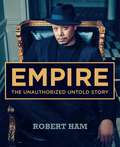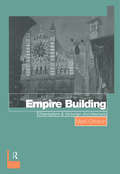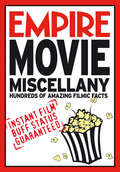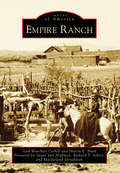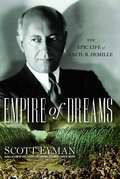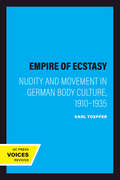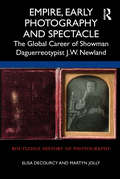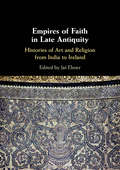- Table View
- List View
Emotional Design in Human-Robot Interaction: Theory, Methods and Applications (Human–Computer Interaction Series)
by Hande Ayanoğlu Emília DuarteWhile social robots participation increases in everyday human life, their presence in diverse contexts and situations is expected. At the same point, users tend to become more demanding regarding their roles, abilities, behaviour and appearance. Thus, designers and developers are confronted with the need to design more sophisticated robots that can produce such a positive reaction from users so as to become well accepted in various cases of use. Like this, Human-Robot Interaction has become a developing area. Emotions are an important part in human life, since they mediate the interaction with other humans, entities and/or products. In recent years, there has been an increase in the importance of emotions applied to the design field, giving rise to the so-called Emotional Design area. In the case of Human-Robot Interaction, the emotional design can help to elicit (e.g., pleasurable) or prevent (e.g., unpleasant) emotional/affective reactions/responses. This book gives a practical introduction to emotional design in human-robot interaction and supports designers with knowledge and research tools to help them take design decisions based on a User-Centred Design approach. It should also be useful to people interested in design processes, even if not directly related to the design of social robots but, instead, to other technology-based artefacts. The text is meant as a reference source with practical guidelines and advice for design issues.
Emotional Engineering vol. 2
by Shuichi FukudaIn an age of increasing complexity, diversification and change, customers expect services that cater to their needs and to their tastes. Emotional Engineering vol 2. describes how their expectations can be satisfied and managed throughout the product life cycle, if producers focus their attention more on emotion. Emotional engineering provides the means to integrate products to create a new social framework and develops services beyond product realization to create of value across a full lifetime. 14 chapters cover a wide range of topics that can be applied to product, process and industry development, with special attention paid to the increasing importance of sensing in the age of extensive and frequent changes, including: Multisensory stimulation and user experience Physiological measurement Tactile sensation Emotional quality management Mental model Kansei engineering. Emotional Engineering vol 2 builds on Dr Fukuda's previous book, Emotional Engineering, and provides readers with a holistic view of its research and applications, enabling them to make strategic decisions on how they can go further beyond product realization. It is recommended for all pioneers in industry, academia and government, who are making tremendous efforts to work with their customers to create value.
Emotional Ethics of The Hunger Games (Palgrave Film Studies and Philosophy)
by Tarja LaineEmotional Ethics of The Hunger Games expands the ‘ethical turn’ in Film Studies by analysing emotions as a source of ethical knowledge in The Hunger Games films. It argues that emotions, incorporated in the thematic and aesthetic organization of these films, reflect a crisis in moral standards. As such they cultivate ethical attitudes towards such phenomena as totalitarianism, the culture of reality television, and the society of spectacle. The focus of the argument is on cinematic aesthetics, which expresses emotions in a way that highlights their ethical significance, running the gamut from fear through guilt and shame, to love, anger and contempt. The central claim of the book is that these emotions are symptomatic of some moral conflict, which renders The Hunger Games franchise a meaningful commentary on the affective practice of cinematic ethics. ‘’The Hunger Games movies have become iconic symbols for resistance across the globe. Tarja Laine proposes that this is not caused by their status as exciting cinematic spectacles, but by their engaging our emotions. Laine uses The Hunger Games as key texts for understanding our world, demonstrating that ethics do not originate from rational considerations, far removed from those mucky things called emotions. But rather that emotions are at the core of cinematic ethics.”—William Brown, Author of Supercinema: Film-Philosophy for the Digital Age ‘’In this elegantly written exploration of the relationship between aesthetics and emotion in The Hunger Gamestrilogy, Tarja Laine illuminates the power of film to embody ethical conflict. Deftly interweaving film-philosophy and close analysis, Laine traces how these films mobilise complex emotions, nuancing our thinking about cinema and the spectator. Laine’s book takes The Hunger Games films seriously, demonstrating with verve why they matter.”—Catherine Wheatley, Senior Lecturer in Film Studies, King’s College London, UK ''In this fresh, engaging, and insightful study of The Hunger Games film trilogy, Tarja Laine explores the crucial role that emotions play in appreciation of the ethical qualities of the movies. She forges productive dialogues between a range of film theory, scholarship on moral philosophy, and debates on ethics, as she performs a multi-layered investigation of the aesthetic qualities of the trilogy, the multiple emotions embodied in these qualities, and the philosophical-ethical insights that are in turn embedded in these emotions. The cinematic connection between emotions and ethics that emerges through Laine’s detailed textual analyses confronts us with complex moral dilemmas while enriching our aesthetic experience.'' —Sarah Cooper, Professor, Film Studies Department, King's College London, UK
Emotional Rooms
by Benjamin Noriega-Ortizemotional ROOMS the sensual interiors of benjamin noriega-ortiz Named by House Beautiful as one of "America's Most Brilliant Decorators" for ten consecutive years, Benjamin Noriega-Ortiz is recognized as one of the most stylish and influential of today's interior designers. His sensuous, glamorous, and ethereal work captures an unusual sense of openness and light through the use of color, materials, architecture, and the unexpected integration of fashion. Noriega-Ortiz has traveled the world to design spaces for such clients as rock superstar Lenny Kravitz, bestselling author Laura Esquivel, and celebrity photographer Mark Seliger. Now, with Emotional Rooms, he shares his process with anyone who may not have access to a high-end designer but wants a home or workspace that is at once beautiful and true to themselves. Noriega-Ortiz brings together in this book not only photographs of his interiors but personal images that will inspire and evoke the designer within us all. With stunning full-color photographs and clear, concise essays, he guides readers through the essential principles of design -- color, architecture, furniture, and lighting -- and gives advice on how homeowners can prevent common mistakes. He shows them how to break the rules, ignore trends and labels, stop pleasing others, and decorate their homes to reflect their own true desires. For those influenced by passing fads and fashions, Noriega-Ortiz's essential advice is: Emotion is always a better guide than intellect when it comes to creating a richly satisfying environment. Home truly is where the heart is, and this famous designer has what it takes to help readers put the heart back into their homes.
Emotional Settings in Early Modern Pedagogical Culture: Hamlet, The Faerie Queene, and Arcadia
by Judith OwensThis book is notable for bringing together humanist schooling and familial instruction under the banner of emotions and for studying seminal works of early modern literature within this new analytical context. It thus furnishes unique ways to think about two closely interrelated moral imperatives: shaping boys into civil subjects; and fashioning heroic agency and selfhood in literature. In tracing the emotional dynamics of the humanist classroom, this book shows just how thoroughly school could accommodate resistance to authority and foster unruly boys. In gauging the emotional pressures at work in filial relationships, it shows how profoundly sons could experience patriarchal authority as provisional, negotiable, or damaging. In turning to Shakespeare’s Hamlet, Spenser’s Prince Arthur, and Sidney’s Arcadian heroes, Emotional Settings highlights the ways in which the respective emotional and moral imperatives of home and school could bring conflicting pressures to bear in the formation of heroic agency – and at what cost. Engaging and accessible, this book will appeal to scholars interested in early modern literature, pedagogy, histories of emotion, and histories of the family, as well as to graduate students and advanced undergraduate students in these fields.
Emotional and Behavioral Problems: A Handbook for Understanding and Handling Students
by Richard L. Simpson Paul Zionts Laura ZiontsA guide to teaching students with emotional and behavioral problems.
Emotionally Durable Design: Objects, Experiences and Empathy
by Jonathan ChapmanEmotionally Durable Design presents counterpoints to our ‘throwaway society’ by developing powerful design tools, methods and frameworks that build resilience into relationships between people and things. The book takes us beyond the sustainable design field’s established focus on energy and materials, to engage the underlying psychological phenomena that shape patterns of consumption and waste. In fluid and accessible writing, the author asks: why do we discard products that still work? He then moves forward to define strategies for the design of products that people want to keep for longer. Along the way we are introduced to over twenty examples of emotional durability in smart phones, shoes, chairs, clocks, teacups, toasters, boats and other material experiences.Emotionally Durable Design transcends the prevailing doom and gloom rhetoric of sustainability discourse, to pioneer a more hopeful, meaningful and resilient form of material culture. This second edition features pull-out quotes, illustrated product examples, a running glossary and comprehensive stand firsts; this book can be read cover to cover, or dipped in-and-out of. It is a daring call to arms for professional designers, educators, researchers and students from in a range of disciplines from product design to architecture; framing an alternative genre of design that reduces the consumption and waste of resources by increasing the durability of relationships between people and things.
Emotions and Architecture: Forging Mediterranean Cities Between the Middle Ages and Early Modern Time (Routledge Research in Architectural History)
by Francesca Lembo Fazio Valentina TomassettiEmotions and Architecture: Forging Mediterranean Cities Between the Middle Ages and Early Modern Time explores architecture as a medium to arouse or conceal emotions, to build consensus through shared values, or to reconnect the urban community to its alleged ancestry. The chapters in this edited collection outline how architectonic symbols, images, and structures were codified – and sometimes recast – to match or to arouse emotions awakened by wars, political dominance, pandemic challenges, and religion. As signs of spiritual and political power, these elements were embraced and modulated locally, providing an endorsement to authorities and rituals for the community. This volume provides an overview of the phenomenon across the Italian region, stressing the transnationality of selected symbols and their various declinations in local contexts. It deepens the issue of refitting symbols, artworks, and structures to arouse emotions by carefully analysing specific cases, such as the Septizodium in Rome, the Holy House of Loreto in Venice, and the reconstruction of L'Aquila. The collection, through its variegated contributions, offers a comprehensive view of the phenomenon: exploring the issue from political, social, religious, and public health perspectives, and seeking to propose a new definition of architecture as a visual emotional language. Together, the chapters show how the representation of virtues and emotions through architecture was part of a symbolic practice shared by many across the Italian context. This book will be of interest to researchers and students studying architectural history, the history of emotions, and the history of art.
Emotions in Contemporary TV Series
by Alberto Garc�aThis edited collection offers a wide range of essays showcasing current research on emotions in TV series. The chapters develop from a variety of research traditions in film, television and media studies and explores American, British, Nordic and Spanish TV series.
Emotions in Technology Design: From Experience to Ethics (Human–Computer Interaction Series)
by Pertti Saariluoma Jaana Leikas Rebekah RousiUnderstanding emotions is becoming ever more valuable in design, both in terms of what people prefer as well as in relation to how they behave in relation to it. Approaches to conceptualising emotions in technology design, how emotions can be operationalised and how they can be measured are paramount to ascertaining the core principles of design. Emotions in Technology Design: From Experience to Ethics provides a multi-dimensional approach to studying, designing and comprehending emotions in design. It presents emotions as understood through basic human-technology research, applied design practice, culture and aesthetics, ethical approaches to emotional design, and ethics as a cultural framework for emotions in design experience. Core elements running through the book are: cognitive science – cognitive-affective theories of emotions (i.e., Appraisal); culture – the ways in which our minds are trained to recognise, respond to and influence design; and ethics – a deep cultural framework of interpretations of good versus evil. This ethical understanding brings culture and cognition together to form genuine emotional experience. This book is essential reading for designers, technology developers, HCI and cognitive science scholars, educators and students (at both undergraduate and graduate levels) in terms of emotional design methods and tools, systematic measurement of emotion in design experience, cultural theory underpinning how emotions operate in the production and interaction of design, and how ethics influence basic (primal) and higher level emotional reactions. The broader scope equips design practitioners, developers and scholars with that ‘something more’ in terms of understanding how emotional experience of technology can be positioned in relation to cultural discourse and ethics.
Emotions, Ethics, and Cinematic Experience: New Phenomenological and Cognitivist Perspectives
by Robert SinnerbrinkSince the early 1990s, phenomenology and cognitivism have become two of the most influential approaches to film theory. Yet far from being at odds with each other, both approaches offer important insights on our subjective experience of cinema. Emotions, Ethics, and Cinematic Experience explores how these two approaches might work together to create a philosophy of film that is both descriptively rich and theoretically productive by addressing the key relationship between cinematic experience, emotions, and ethics.
Empathetic Space on Screen
by Amedeo D'AdamoIn this book we learn that there is a clear but complex relationship between setting and character on screen. Certain settings stand out above others—think of the iconic gooey dripping tunnels that Ripley stumbles through in Aliens, Norman’s bird-decorated parlour in Psycho or the dark Gotham of certain Batman movies. But what makes these particular settings so powerful and iconic? Amedeo D’Adamo explains why we care about and cry for certain characters, and then focuses on how certain places then become windows onto their emotional lives. Using popular case studies such as Apocalypse Now, Amelie, Homeland and The Secret Garden, this original and insightful book is the first to really explain what makes some settings so effective, revealing an important but as yet uncovered machinery of empathy in visual narrative space. An invaluable resource for students, academics and indeed young filmmakers designing their very own narratives for space on screen.
Empathie und Parteilichkeit gegenüber fiktionalen Figuren in Videospielen: Eine Analyse von narrativen Strategien am Beispiel von “The Last of Us Part II” (BestMasters)
by Anja SegschneiderWie entstehen Empathie und Parteilichkeit in interaktiven Medien? Ausgehend von der These, dass interaktive Medien wie Videospiele eher dazu in der Lage sind, Empathie und Parteilichkeit zu erzeugen als lineare Medien, geht die Arbeit dieser Frage nach. Als Beispiel dient das populäre Survival-Horror-Spiel „The Last of Us Part II“ aus dem Jahr 2020. Das theoretische Fundament bilden bestehende Theorien aus Film- und Medienwissenschaft sowie der Psychologie, die auf das interaktive Medium übertragen und angepasst werden. Ein Fokus liegt auf narrativen und ludonarrativen Strategien. Dabei schlägt die Arbeit auch einen Bogen zu gesamtgesellschaftlichen Trends in den Medien und analysiert, inwiefern die Strategien für Parteilichkeit und Empathie in interaktiven Medien einen nachhaltigen Einfluss in der realen Welt entfalten können.
Empathy and Business Transformation
by Satu Miettinen Melanie SarantouDue to its potential transformative nature, empathy has increasingly received attention in business, psychology, neuroscience, education, medicine, social sciences and design, to mention only a few. During the last two decades, discussions about the role of empathy in design and creative research and practice have developed, with empathy perceived as a key instrument in human-centred design and design thinking. This book revisits the powerful concept of empathy in the new post-pandemic era in which ubiquitous digitalisation presents challenges to retaining human-centredness when developing products and services. The book presents a practical four-step approach to the challenges presented concerning how organisations can turn from merely feeling empathy with or for people, to actions of empathy and compassion that can be implemented with and by communities. A wide range of organisations and organisational settings can benefit from the presented case studies and research methods. Through them, the book explores how to discover, share and act with empathy and compassion in the new digitally driven post-pandemic era to innovate across a wide range of organisations, including for-profit and not-for-profit businesses and those in the public and third sectors. This edited volume will appeal to global researchers in the fields of product and service design and digital, social innovation, as well those interested in organisational development. The practical, interdisciplinary nature of the book and innovative four-step approach will also appeal to upper-level students.
Empathy and Performance: Enactments of Power in Latinx America (Performing Latin American and Caribbean Identities)
by Laura V. SándezEmpathy and Performance advances a study of empathy and enactments of power by examining works from author-actors whose performances explore the boundaries between two kinship positions. Author Laura V. Sández studies the dramatized dilemma of cultural understanding in &“Our America,&” a notion that refers first to a collective political identity marking a common belonging in the Spanish-speaking America but also alludes to current struggles in the contemporary US. This book sees empathy as an affective response grounded in subjectivity and kinship. Sández argues that to conceptualize empathy one needs to understand how subjects organize, classify, and limit themselves, not only as agents, but also as interpreters. What sort of affiliations do these performances promote? How do they break, reinforce, or queer societal expectations about the Latinx body, the white body, or simply, the staged body? To survey different answers to these queries, Sández studies Indigurrito (Nao Bustamante); Dominicanish (Josefina Báez); ¡Bienvenidos Blancos! or Welcome White People! (Alex Torra); the apology delivered by the group Veterans Stand with Standing Rock during protests against the Dakota Access Pipeline; and Kukuli Velarde&’s body of work, from We, the Colonized Ones to A Mi Vida. In these artistic enactments, which range from 1992 to 2021, the historical construct of boundaries and bodies becomes evident. Following recent work on empathy by Lanzoni, Maibom, Calloway-Thomas, Bloom, Hogan, and Matravers, among others, Sández examines in-group/out-group divisions, the establishment of identity categories through performance, and the exploration of subaltern identities.
Empire
by Robert HamAn unofficial guide to EMPIRE, the runaway hit of the 2014-15 television season.Empire is the breakout, network television hit of 2015--from its opening night, viewers were riveted by the story of record company magnate Lucious Lyon and his family, and the struggle for control over Empire Entertainment. As the second season approaches this September, Empire: The Unauthorized Untold Story tells you everything you need to know about this powerful drama. You'll get full backgrounds on all the major players, including the real-life entertainment icons on whom their stories are based. You'll learn about the music and fashions that helped drive the show's success. And you'll get a hint of what the second season might hold as show creators Lee Daniels and Danny Strong prepare to build on their phenomenal opening act.
Empire Builders: An Illustrated History of the Rise and Fall of Cleveland's Van Sweringen Brothers
by Lauren R. PaciniEmpire Builders tells the story of Oris P. and Mantis J. Sweringen, two brothers from Wooster, Ohio, in the late nineteenth and early twentieth centuries. Although they were born into abject poverty, Oris was an extraordinary visionary who, with the help of his devoted younger brother, amassed a vast fortune in real estate and railroad developments. Their major breakthrough came in 1913 with the establishment of Shaker Heights, an affluent garden suburb connected by a brand-new interurban railroad to the booming midwestern metropolis of Cleveland. The Van Sweringens' ascension after Shaker Heights was meteoric, and it culminated with the construction of the 52-story Terminal Tower in downtown Cleveland in 1927. However, the country's economy came crashing down after the 1929 stock market collapse, and their empire crumbled around them. Empire Builders is the first new biography of the Van Sweringen brothers in more than twenty years. In it, architectural photographer and local history author Lauren R. Pacini tells the remarkable story of the Van Sweringen brothers through words and images. This richly illustrated volume features more than 150 new photographs of the still-fabulous historic homes the brothers built throughout greater Cleveland.The foreword is written by John J. Grabowski.
Empire Building: Orientalism and Victorian Architecture
by Mark CrinsonThe colonial architecture of the nineteenth century has much to tell us of the history of colonialism and cultural exchange. Yet, these buildings can be read in many ways. Do they stand as witnesses to the rapacity and self-delusion of empire? Are they monuments to a world of lost glory and forgotten convictions? Do they reveal battles won by indigenous cultures and styles? Or do they simply represent an architectural style made absurdly incongruous in relocation? Empire Building is a study of how and why Western architecture was exported to the Middle East and how Islamic and Byzantine architectural ideas and styles impacted on the West. The book explores how far racial theory and political and religious agendas guided British architects (and how such ideas were resisted when applied), and how Eastern ideas came to influence the West, through writers such as Ruskin and buildings such as the Crystal Palace. Beautifully written and lavishly illustrated, Empire Building takes the reader on an extraordinary postcolonial journey, backwards and forwards, into the heart and to the edge of empire.
Empire Films and the Crisis of Colonialism, 1946–1959
by Jon CowansThe first transnational history of cinema’s role in decolonization.Using popular cinema from the United States, Britain, and France, Empire Films and the Crisis of Colonialism, 1946–1959, examines postwar Western attitudes toward colonialism and race relations. Historians have written much about the high politics of decolonization but little about what ordinary citizens thought about losing their empires. Popular cinema provided the main source of images of the colonies, and, according to Jon Cowans in this far-reaching book, films depicting the excesses of empire helped Westerners come to terms with decolonization and even promoted the dismantling of colonialism around the globe.Examining more than one hundred British, French, and American films from the post–World War II era, Cowans concentrates on movies that depict interactions between white colonizers and nonwhite colonial subjects, including sexual and romantic relations. Although certain conservative films eagerly supported colonialism, Cowans argues that the more numerous "liberal colonialist" productions undermined support for key aspects of colonial rule, while a few more provocative films openly favored anticolonial movements and urged "internal decolonization" for people of color in Britain, France, and the United States.Combining new archival research on the films’ production with sharp analysis of their imagery and political messages, the book also assesses their reception through box-office figures and newspaper reviews. It examines both high-profile and lesser-known films on overseas colonialism, including The King and I, Bhowani Junction, and Island in the Sun, and tackles treatments of miscegenation and "internal colonialism" that appeared in Westerns and American films like Pinky and Giant. The first truly transnational history of cinema’s role in decolonization, this powerful book weaves a unified historical narrative out of the experiences of three colonial powers in diverse geographic settings.
Empire Movie Miscellany: Instant Film Buff Status Guaranteed
by Empire MagazineFrom the team who brought you The Empire Film Guide, here are all the obscure, indecent and downright bizarre movie facts and figures that were not considered sensible for a practical film guide. Discover which country translated GI Jane as Satan Female Soldier, which Hollywood heartthrob is the lead singer of 30 Odd Foot of Grunts, and which country takes a bag of toasted leaf cutter ants to the cinema instead of popcorn! The Schott's Miscellany of movies, packed full of movie facts, figures and lists, as well as explanations of filmmaking terminology and a "shot miscellany" - a list of all the various camera shots. You will soon know your Oscar Hosts from your Monty Python French insults, and never be short of small talk again!
Empire Ranch
by Gail Waechter Corkill Sharon E. HuntThe Empire Ranch sits in the heart of the rolling grasslands and oak-studded foothills of Las Cienegas National Conservation Area in southeastern Arizona. Its remarkable history and the ranching way of life are told through the stories of the men, women, and children of the Empire, most notably the Vail, Boice, and Donaldson families. Walter L. Vail and Herbert R. Hislop purchased the Empire Ranch homestead for $2,000 in 1876. The Vail family operated the ranch until 1928, turning it into a cattle ranching empire. From 1928 to 1975, the well-respected Boice family ran a vibrant Hereford operation on the Empire. The Donaldson family used innovative range management methods to continue the ranching legacy from 1975 to 2009. Today, the ranch, under the management of the Bureau of Land Management, remains one of the oldest continuously working cattle ranches in the region.
Empire of Dreams: The Epic Life of Cecil B. DeMille
by Scott EymanBEST KNOWN AS THE DIRECTOR of such spectacular films as The Ten Commandments and King of Kings, Cecil B. DeMille lived a life as epic as any of his cinematic masterpieces. As a child DeMille learned the Bible from his father, a theology student and playwright who introduced Cecil and his older brother, William, to the theater. Tutored by impresario David Belasco, DeMille discovered how audiences responded to showmanship: sets, lights, costumes, etc. He took this knowledge with him to Los Angeles in 1913, where he became one of the movie pioneers, in partnership with Jesse Lasky and Lasky’s brother-in-law Samuel Goldfish (later Goldwyn). Working out of a barn on streets fragrant with orange blossom and pepper trees, the Lasky company turned out a string of successful silents, most of them directed by DeMille, who became one of the biggest names of the silent era. With films such as The Squaw Man, Brewster’s Millions, Joan the Woman, and Don’t Change Your Husband, he was the creative backbone of what would become Paramount Studios. In 1923 he filmed his first version of The Ten Commandments and later a second biblical epic, King of Kings, both enormous box-office successes. Although his reputation rests largely on the biblical epics he made, DeMille’s personal life was no morality tale. He remained married to his wife, Constance, for more than fifty years, but for most of the marriage he had three mistresses simultaneously, all of whom worked for him. He showed great loyalty to a small group of actors who knew his style, but he also discovered some major stars, among them Gloria Swanson, Claudette Colbert, and later, Charlton Heston. DeMille was one of the few silent-era directors who made a completely successful transition to sound. In 1952 he won the Academy Award for Best Picture with The Greatest Show on Earth. When he remade The Ten Commandments in 1956, it was an even bigger hit than the silent version. He could act, too: in Billy Wilder’s classic film Sunset Boulevard, DeMille memorably played himself. In the 1930s and 1940s DeMille became a household name thanks to the Lux Radio Theater, which he hosted. But after falling out with a union, he gave up the program, and his politics shifted to the right as he championed loyalty oaths and Sen. Joseph McCarthy’s anticommunist witch hunts. As Scott Eyman brilliantly demonstrates in this superbly researched biography, which draws on a massive cache of DeMille family papers not available to previous biographers, DeMille was much more than his clichéd image. A gifted director who worked in many genres; a devoted family man and loyal friend with a highly unconventional personal life; a pioneering filmmaker: DeMille comes alive in these pages, a legend whose spectacular career defined an era.
Empire of Ecstasy: Nudity and Movement in German Body Culture, 1910–1935 (Weimar and Now: German Cultural Criticism #13)
by Karl ToepferEmpire of Ecstasy offers a novel interpretation of the explosion of German body culture between the two wars—nudism and nude dancing, gymnastics and dance training, dance photography and criticism, and diverse genres of performance from solo dancing to mass movement choirs. Karl Toepfer presents this dynamic subject as a vital and historically unique construction of "modern identity." The modern body, radiating freedom and power, appeared to Weimar artists and intelligentsia to be the source of a transgressive energy, as well as the sign and manifestation of powerful, mysterious "inner" conditions. Toepfer shows how this view of the modern body sought to extend the aesthetic experience beyond the boundaries imposed by rationalized life and to transcend these limits in search of ecstasy. With the help of much unpublished or long-forgotten archival material (including many little-known photographs), he investigates the process of constructing an "empire" of appropriative impulses toward ecstasy. Toepfer presents the work of such well-known figures as Rudolf Laban, Mary Wigman, and Oskar Schlemmer, along with less-known but equally fascinating body culture practitioners. His book is certain to become required reading for historians of dance, body culture, and modernism.
Empire, Early Photography and Spectacle: The Global Career of Showman Daguerreotypist J.W. Newland (Routledge History of Photography)
by Martyn Jolly Elisa deCourcyJames William Newland’s (1810–1857) career as a showman daguerreotypist began in the United States but expanded into Central and South America, across the Pacific to New Zealand and colonial Australia and onto India. Newland used the latest developments in photography, theatre and spectacle to create powerful new visual experiences for audiences in each of these volatile colonial societies. This book assesses his surviving, vivid portraits against other visual ephemera and archival records of his time. Newland’s magic lantern and theatre shows are imaginatively reconstructed from textual sources and analysed, with his short, rich career casting a new light on the complex worlds of the mid-nineteenth century. It provides a revealing case study of someone brokering new experiences with optical technologies for varied audiences at the forefront of the age of modern vision. This book will be of interest to scholars in art and visual culture, photography, the history of photography and Victorian history.
Empires of Faith in Late Antiquity: Histories of Art and Religion from India to Ireland
by Jaś ElsnerThis book reveals the rewards of exploring the relationship between art and religion in the first millennium, and the particular problems of comparing the visual cultures of different emergent and established religions of the period in Eurasia - Buddhism, Hinduism, Zoroastrianism, Islam, Judaism, Christianity and the pagan religions of the Roman world. Most of these became established and remained in play as what are called 'the world religions'. The chapters in this volume show how the long traditions of studying these topics are caught up in complex local, ancestral, colonial and post-colonial discourses and biases, which have made comparison difficult. The study of Late Antiquity turns out also to be an examination of the intellectual histories of modernity.
